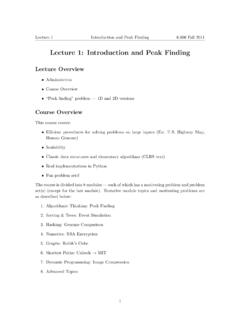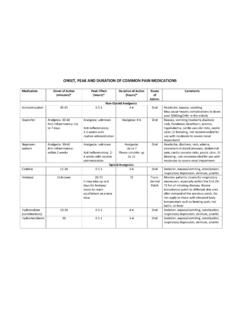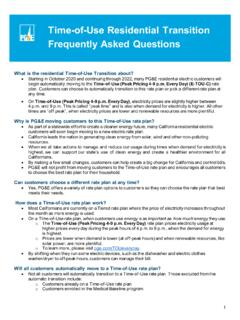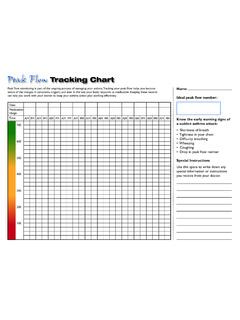Transcription of Unemployment Rates During the COVID-19 Pandemic - FAS
1 Unemployment Rates During the COVID-19 Pandemic Updated August 20, 2021 Congressional Research Service R46554 Congressional Research Service SUMMARY Unemployment Rates During the COVID-19 Pandemic The COVID-19 Pandemic has had a significant effect on labor market metrics for every state, economic sector, and major demographic group in the United States. This report provides information on Unemployment Rates , labor force participation Rates , and nonfarm payrolls in the United States During the ongoing Pandemic . It presents CRS analysis of overall Unemployment rate trends During the Pandemic . The report first examines these trends nationally, and then at the state and industrial levels. Next, it examines how Unemployment Rates varied across demographic groups. The report then repeats this analysis, where appropriate, for the labor force participation rate, which sheds light on the size of the workforce willing and available for work.
2 The final portion of the report analyzes the impact the Pandemic has had on overall employment and by sector. Among other findings, this report shows the following: In April 2020, the Unemployment rate reached the highest rate observed since data collection began in 1948. In July 2021, Unemployment remained higher ( ) than it had been in February 2020 ( ). The labor force participation rate declined to in April 2020 a level not seen since the early 1970s then began a partial recovery in May 2020. The labor force participation rate was in July 2021, percentage points below the level in January 2020, before the Pandemic and the economic recession. Nonfarm payrolls shed million jobs between January 2020 and April 2020, with employment declining to 86% of its pre-recession level. In July 2021, aggregate employment remained million jobs below its pre-recession level.
3 The COVID-19 Pandemic has impacted economic sectors disparately. The leisure and hospitality sector lost the largest number of jobs since January 2020, and persons last employed in this sector have consistently exhibited some of the highest Unemployment Rates throughout the Pandemic . Additionally, the education and services sector and the government sector have exhibited the second and third-largest losses in jobs since January 2020, despite relatively low Unemployment Rates among persons last employed in these sectors. The COVID-19 Pandemic has impacted demographic groups disparately. Although all demographic groups were affected, persons identifying as Black or Hispanic and younger workers generally experienced relatively high peaks in Unemployment and relatively steep declines in labor force participation over the course of the Pandemic .
4 Additionally, persons with lower educational attainment have generally experienced relatively higher Unemployment Rates and lower labor force participation throughout the Pandemic . R46554 August 20, 2021 Gene Falk, Coordinator Specialist in Social Policy Paul D. Romero Research Assistant Isaac A. Nicchitta Research Assistant Emma C. Nyhof Research Assistant Unemployment Rates During the COVID-19 Pandemic Congressional Research Service Contents Introduction .. 1 Unemployment Rate: Historical Trends .. 2 Comparing the Great Recession and the COVID-19 Recession .. 5 COVID-19 Recession: Unemployment 5 Unemployment Rates by State .. 6 Unemployment Rates by Sector .. 7 Unemployment Rates for Full- and Part-Time 9 Unemployment Rates by Sex and Age .. 10 Unemployment Rates by Racial Group and Hispanic Ethnicity.
5 11 Unemployment Rates by Education .. 13 Labor Force Participation Rate: Historical Trends .. 13 COVID-19 Recession: Trends in Labor Force Participation .. 15 Labor Force Participation Rate by Age and Sex .. 15 Labor Force Participation Rate by Race and Ethnicity .. 16 Labor Force Participation Rate by Educational 18 COVID-19 Recession: Nonfarm Payrolls .. 19 Trends in Employment in the Private Sector .. 20 Trends in Employment by Government Sector .. 21 Data Limitations and 22 COVID 19 Pandemic -Related Data Issues .. 23 General Data Caveats .. 24 Figures Figure 1. Historical Unemployment Rate .. 3 Figure 2. Unemployment 5 Figure 3. State Unemployment Rate .. 6 Figure 4. Unemployment Rates by Sector .. 8 Figure 5. Unemployment Rates for Part- and Full-Time Workers .. 10 Figure 6. Unemployment Rates by Sex and 11 Figure 7.
6 Unemployment Rates by Racial 12 Figure 8. Unemployment Rates by Hispanic Origin .. 12 Figure 9. Unemployment Rates by Education .. 13 Figure 10. Historical Labor Force Participation Rate .. 14 Figure 11. Labor Force Participation Rate During COVID-19 15 Figure 12. Labor Force Participation Rates by Age and Sex .. 16 Figure 13. Labor Force Participation Rate by Race .. 17 Figure 14. Labor Force Participation Rate by Hispanic 18 Figure 15. Labor Force Participation Rate by Educational Attainment .. 19 Figure 16. Change in Employment by Sector .. 20 Figure 17. Change in Employment in the Private Sector .. 21 Unemployment Rates During the COVID-19 Pandemic Congressional Research Service Figure 18. Change in Employment in the Public Sector .. 22 Contacts Author Information .. 24 Unemployment Rates During the COVID-19 Pandemic Congressional Research Service 1 Introduction The National Bureau of Economic Research (NBER) declared February 2020 as the start of the most recent economic downturn, marking the end of the longest period of expansion in This expansion followed the Great Recession (December 2007 to June 2009), a downturn widely considered to be the worst since the Great Depression (August 1929 to March 1933).
7 2 The Unemployment rate rose quickly in March 2020, and by April 2020 it had greatly surpassed its previous peaks observed During and just after the Great Recession. This rise in Unemployment was caused by an unprecedented loss of million jobs between January 2020 and April 2020. Many individuals left the labor force over this period, and by April 2020 the labor force participation rate3 declined to , a level not seen since the early 1970s. In July 2021, the NBER declared that the recession that was triggered at the beginning of the COVID-19 Pandemic ended in April This makes the COVID-19 recession the shortest recession on record. This deterioration in the labor market corresponded with various advisory or mandated stay-at-home orders implemented in response to the COVID-19 Pandemic and other Pandemic -related factors affecting States and localities implemented these orders6 to mitigate the risks of COVID-19 after it was declared a Pandemic disease by the World Health Organization on March 11, This report discusses the state of the labor market using data from the Bureau of Labor Statistics (BLS).
8 The three primary sources are the Current Population Survey (CPS), the Local Area Unemployment Statistics (LAUS) program, and the Current Employment Statistics (CES) program. In addition to the usual caveats about estimates (see the General Data Caveats section), there were additional data challenges caused by the COVID-19 Pandemic (see the COVID-19 Pandemic -Related Data Issues section). The Pandemic led to lower survey response Rates by businesses and households. Additionally, the BLS detected an error in certain agency categorization procedures that likely underestimated Unemployment early in the Labor 1 T he Nat ional Bureau of Economic Research; see ht t ml for t heir hist orical series of expansions and cont ract ions. For more on t heir process for det ermining expansions and cont ract ions, see ht t ml#:~:t ext =What %20is%20an%20expansion%3F,more%20than%20 a%20few% he%20normal%20st ate,economy%3B%20most %20recessions%20are%20brief.
9 2 T he Great Recession was a part icularly long recession, characterized by a st eady and large increase in Unemployment and unprecedent ed decreases in labor force part icipat ion. T he Unemployment rat es observed During t he Great Recession, however, never surpassed t hose of t he early 1980s. For more on labor force met rics During t he Great Recession see CRS Report R45330, Labor Market Patterns Since 2007, by Sarah A. Donovan and Marc Labont e. 3 Defined as t he percent age of persons in t he overall adult populat ion who eit her have a job or are looking for a job. 4 For more informat ion on t he det ermination of t his end dat e, see ht t ing-commit t ee-announcement-july-19-2021. 5 See CRS Insight IN11388, COVID-19 : Econom ic Effects, by Rena S. Miller and Marc Labont e. 6 For a list of st at e-level st ay-at-home orders and est imat es of t he impact of t hese orders on risk mit igat ion, see Amanda Moreland, Christ ine Herlihy, and Michael A.
10 T ynan et al., Tim ing of State and Territorial COVID-19 Stay-at-Hom e Orders and Changes in Population Movem ent, Cent ers for Disease Cont rol, Morbidit y and Mort ality Weekly Report Vol. 69 No. 35, Washingt on, DC, Sept ember 4, 2020, pp. 1198-1203, 7 World Healt h Organizat ion, Coronavirus Disease 2019 ( COVID-19 ), Sit uat ion Report 51, March 11, 2020, p. 1, ht t /docs/default-source/coronaviruse/sit uat ion-report 8 See CRS Insight IN11456, COVID-19 : Measuring Unem ploym ent, by Lida R. Weinst ock. Unemployment Rates During the COVID-19 Pandemic Congressional Research Service 2 force participation Rates were not affected by this categorization error and met BLS standards of accuracy, despite depressed response BLS also identified an error in the nonfarm enrollment data processing system wherein some businesses were improperly included in estimates, although BLS has since determined the impacts of this error were Many aspects of the labor market have recovered substantially since the onset of the Pandemic .

















